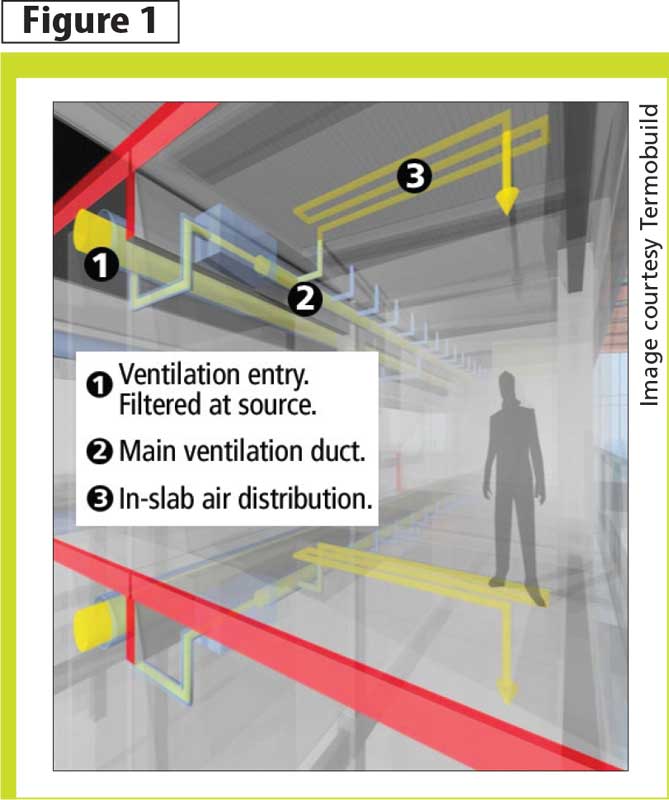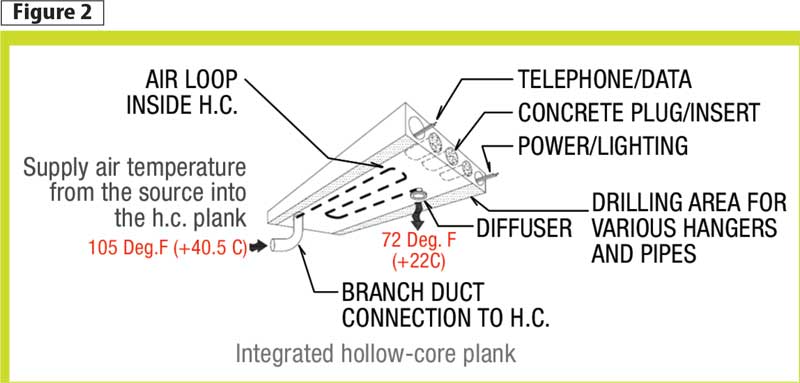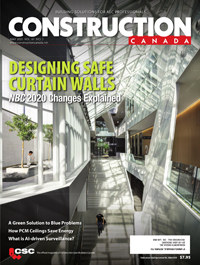Elevating utility of buildings with hollow-core precast concrete slabs

How does concrete keep a building cool?
Concrete partially absorbs heat from the structure and its occupants, essentially removing heat from the space and helping naturally cool the building. At some point during the day, supplementary cooling may be required, but for a relatively short time compared to conventional systems.
By design, hollow-core slabs can intake and store cooler nighttime air, then release it when required. The slab acts as a thermal ‘battery,’ which can harness free cooling when available, and can be mechanically charged at night when conditions are more favourable (i.e. when the sun is down and lights are off). As well, for most of the year, the integration of hollow-core slabs with a ventilation system can increase overall air quality by providing an increased flow of fresh air without the need for supplementary heating or cooling.
In summer, cool night air (i.e. between 10 and 15 C [50 and 60 F]) can not only be circulated, but also stored in precast floors, as shown in Figure 1. In places where the nighttime air is not cool enough, off-peak air refrigeration may be needed to precool buildings.
When cooling or heating a building, dynamic energy exchange between exterior and interior should be considered. The body heat generated by occupants is highly valuable thermal energy in winter, and can be easily harnessed to maintain temperatures in the desired comfort zone without overheating. When the thermal mass of a building is engaged through a hollow-core slab ventilation system, heat gain generated from occupants, lights, and appliances can be stored for later use. Air is kept clean via filtration and is delivered at slightly lower velocities than with a conventional system, which helps ensure concrete particles are not lifted. Hollow-core slab manufacturing also creates minimal concrete particles in the core area.
Getting off the grid
On average, about 75 per cent of the thermal energy available from tempered ventilation air can be absorbed by a hollow-core slab. Consequently, using thermal properties of floors and ceilings as an active battery is less expensive than alternative conventional mechanical systems. At the same time, these systems naturally lend themselves to cost-effective, net-zero construction.

Image courtesy B+H Architects
Radiant air-conditioning systems with thermal storage work intuitively with fan-assisted ventilation systems. The ventilation will push treated fresh air through a series of main ducts, fed into branch ducts formed within the hollow-core slabs of ceilings or floors (Figure 2). As air passes along the ducts, the concrete warms or cools the fresh air before supplying it to the occupied space. The building residents will benefit from both better air quality and controlled temperatures.
Precast, prestressed hollow-core planks can be seamlessly integrated into a building, distributing air through their cores. They can also be tied into various conventional HVAC systems to store energy for later use, helping reduce greenhouse gas (GHG) emissions and overall energy costs. Incorporating systems with a high thermal mass is one way to adapt to the impact of rising temperatures and unstable weather patterns directly linked to climate change.
Buildings implementing these methods can typically withstand significant outdoor temperature changes and even energy disruptions with minimal impact, as the energy storage feature of hollow-core slabs enables building occupants to remain ‘off-grid’ for extended periods. Commonly used in floors and roofs, these systems can be paired with a ventilation system to provide both the thermal mass valued in concrete and an energy storage solution. This type of material adapts well to hot, cold, and humid environments, as it responds to the needs of various occupancy types and climatic zones.
Effectively, hollow-core slabs are an economical solution that can move an inert floor or roof from an idle state to an intelligent one by capturing, storing, and releasing low-grade energy upon demand. This can reduce or eliminate the need for heating and cooling from non-renewable sources and spread the release of energy over a longer time. In case of a power failure or other climate-change-related events, hollow-core concrete slabs will continue to release stored energy, ensuring the building is habitable and providing a sustainable operation solution.







